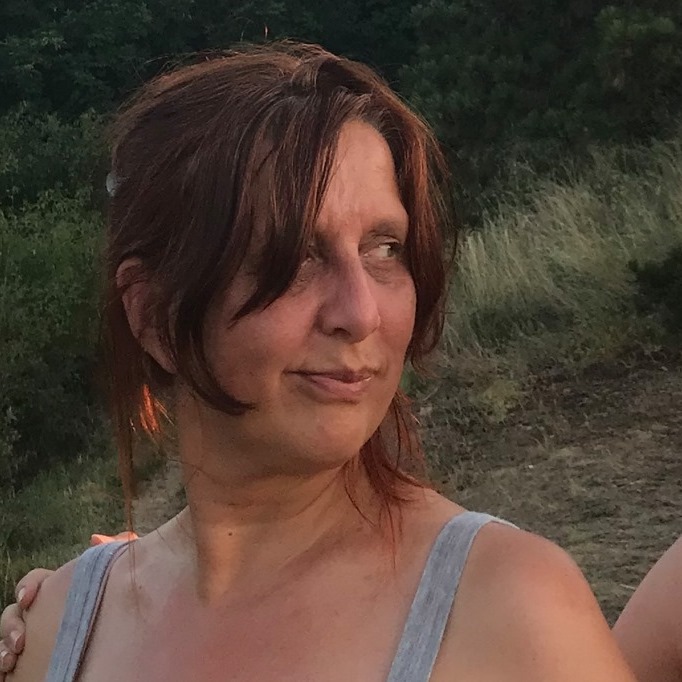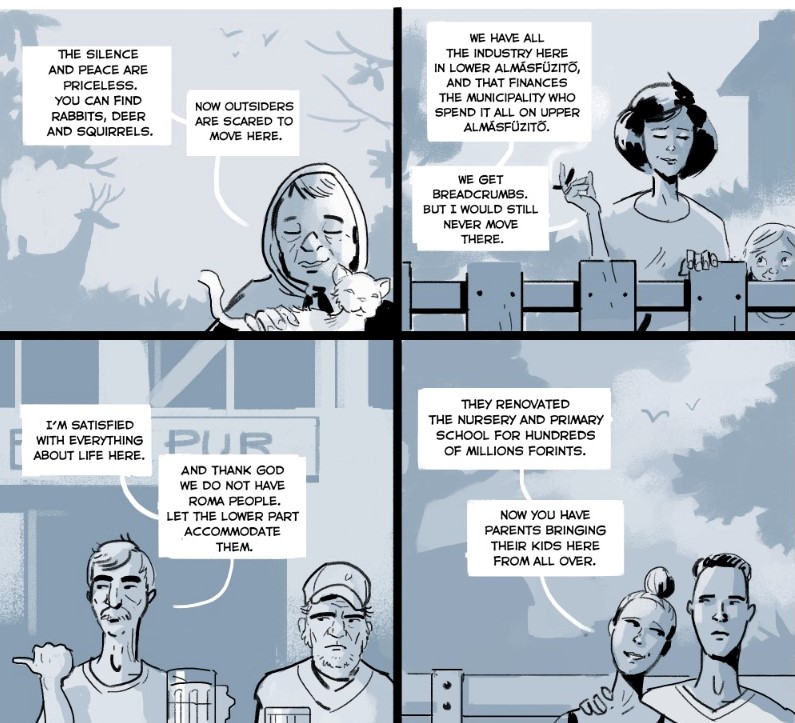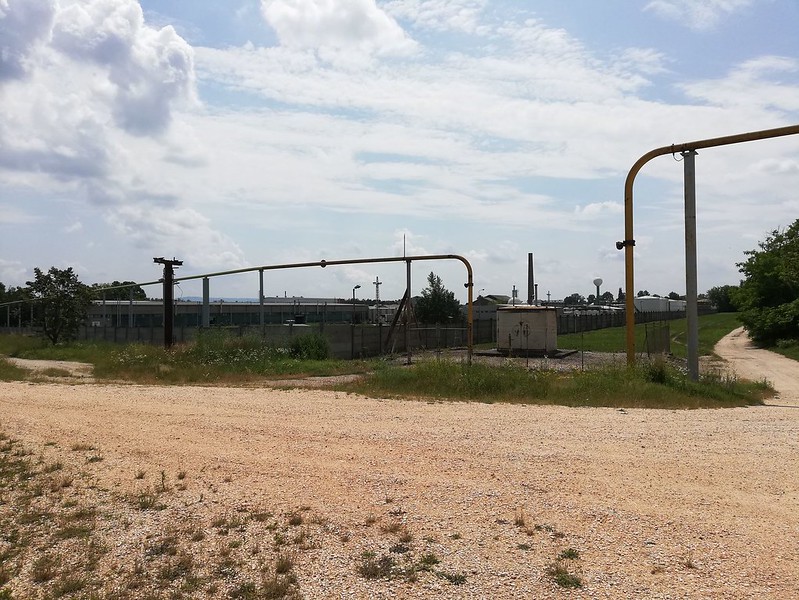The https://english.atlatszo.hu use cookies to track and profile customers such as action tags and pixel tracking on our website to assist our marketing. On our website we use technical, analytical, marketing and preference cookies. These are necessary for our site to work properly and to give us inforamation about how our site is used. See Cookies Policy
Almásfüzitő: a divided settlement in the shadow of the former red mud reservoir
The long-term environmental impact of the red mud reservoirs in Almásfüzitő – now covered with plants or used for landfill – are unknown. Within an international project we investigated the waste treatment facility operated on one of the reservoirs of the former alumina factory there. Together with Atlatszo reporters, researchers from Central European University were also involved in the project focusing on the case of the former red mud reservoirs. We interviewed Alexandra Czeglédi, research assistant and Ian M. Cook, researcher, about how, in their experience, the proximity of such a dangerous plant affects the lives of locals.

We reported in February that TKV’s environmental permit for the handling of general and hazardous waste on the former red sludge reservoir was extended in December for a few months. The reservoirs belonging to the former alumina factory, located right next to the Danube, received a lot of attention after the 2010 red mud disaster in Kolontár. Greenpeace has protested and campaigned several times since then because of the hazardous waste shipped to Almásfüzitő and because of the reservoirs they believe might damage the ground water and leak into the Danube. The organization appealed against the extension of the permit in December. In 2012 an infringement procedure was launched by the European Commission – without much impact – against Hungary because of the way hazardous waste was handled in Almásfüzitő.
Hazardous waste deposit at the red sludge reservoirs in Almásfüzitő was issued a new permit
After several years of waiting, a new environmental permit was granted in December 2019 to Tatai Environmental Protection Ltd. (TKV)’s hazardous waste processing plant at the Almásfüzitő red mud reservoirs.
Years ago, environmental activists made a video entitled “Cancer Street” about the part of Almásfüzitő that is located right next to one of the red mud reservoirs. What were your first impressions when you first visited this place?
Ian: We took the train to a place called Almásfüzitő, and on the map the next stop is called Nagykolónia, and I was under the impression that these were separate settlements. When I arrived in Almásfüzitő and walked out of the train station, I noticed straight away that it was a noisy place next to a main road, with quite a bit of heavy industry, not a particularly nice place to be in. It was only after the second trip that I realised that the first time we only saw one part of Almásfüzitő, and that the settlement is much bigger, it has two parts. The divide between these two was immediately visible in many ways, it did not feel like one settlement, even though administratively this is the case.
Alexandra: When I first arrived in Almásfüzitő , I had the feeling that nothing much is happening there. We ended up in lower Almásfüzitő, the place had an industrial feel, and we saw a lot of construction going on, workers sitting in the park, having lunch. The first thing I noticed was the company MOL, which now operates the lubricant factory set up in the state socialist era but dating back even earlier, and for me it was an empty feeling with the remains of industrial activity. We ended up next to the old alumina factory, and we walked to upper Almásfüzitő (more commonly called Nagykolónia) , which finally had the look of a settlement more than just an industrial place. After walking around and talking to people we became aware of the huge divide.
Was it difficult to get locals to talk to you?
Ian: When we went to the street next to the red sludge reservoir we just knocked on a door, and the very first lady we met was extremely welcoming and also really enthusiastic about living in this settlement. That was a very good experience, and it actually blew all the ideas we might have had previously about living in close proximity of waste remediation and a red mud reservoir. She had a house for sale, but she has not been able to sell this house for years because of the bad reputation that the district, especially her street has. At the same time she tried to show a different side of Almásfüzitő than what was known: the things she stressed about living in Almásfüzitő were, for example living, close to the countryside, being able to go for walks, the trees, the natural surroundings, rabbits, deer and other forest animals.etc. She presented an idyllic ‘village life’. Another woman we spoke to, also living on the same street had a similar attitude, trying to show very hard how things were good. Occasionally we would meet people who were harsh , I put this down partly to the negative press they got before, and partly what Greenpeace did, and because it is known as an ex-industrial settlement with a lot of pollution I can understand the local pride of the villagers who want to show that actually things are good there.
Alexandra: My first impression was that it may be a bit challenging talking to people. In the beginning we mostly talked with elderly people who live alone, I felt that the community there, especially in the street next to the reservoir is not a very close one, people do not really talk to each other much. Some of the locals were not really willing to talk and explain about the neighbourhood, while some of them were more open, especially one man, who was informally appointed as a spokesperson for the locals because some of them seemed to have a kind of fear of talking to the media. They resented that Greenpeace brought a negative image to the street at the time.
Do you think many of today’s inhabitants used to work at the old alumina factory?
Ian: We do not have statistical data about this, but many of the elderly people who we spoke to did indeed work there. The younger generation work outside the settlement. There is not much work there now. There is MOL and a sheet metal company. Some of their workers (ethnic Hungarians) come in from Slovakia, there is a labour shortage in the settlement. There is a general nostalgic view of the settlement’s past in many locals, but elderly people sometimes have a nostalgic view of the past, no matter what It was like, and you can certainly find some of this remembrance of the time when everything was provided for by the state or in this case by the company. The mayor thus struggles with the locals’ expectations. Today there is a crumbling infrastructure, problems with the drinking water (not related to the red sludge, just because of the old pipes). When the company was closed the state took over some of the services that were provided for the locals, but it was not the same anymore. Some of the facilities used to be free here. This is certainly something that people reflected on when we talked to them.
Alexandra: One of the people I interviewed was an engineer who moved there in the 1970 to work for the alumni factory. At the time this was a very attractive place for young engineers, with such benefits as free housing and heating, There good sports facilities, In the late 1970s there was a kind of state socialist switch towards environmental consciousness, promoting a healthier life for the locals there too, but it was mostly experienced in upper Almásfüzitő. In lower Almásfüzitő it was the company MOL providing the facilities, in upper Almásfüzitő it was the alumina factory. Upper Almásfüzitő is more prosperous and lower Almásfüzitő was kind of left behind when the local government took over the maintenance of the facilities and the local infrastructure.
Ian: The place was almost completely destroyed by bombs in World War II, so it had to be rebuilt from scratch. They wanted to create a model settlement to display the best of socialist society. It must be difficult to reconcile with this today, that this place which was once central in the national economy has lost its main purpose, and it is now a place of waste remediation. The reputation of Almásfüzitő is very different now. This shift must be difficult to conceptualise for some of the elderly residents. Also there’s a high end use of the settlement, like the boat club which mostly for people from outside the settlement, they just store their boats there.
Childcare institutions are famously good there so people from other settlements also bring their children to the local nursery. This is all in upper Almásfüzitő though. Despite all there are some pretty good facilities and Almásfüzitő is well connected: it is close to a main road and there is a very good train line which can get you to Budapest in a bit more than an hour. Upper Almásfüzitő is actually a great place, it has good housing and a nice central square. Everything is kept in pretty decent order. It feels like a nice place to be, a bit out of sync with the way Almásfüzitő is often portrayed nowadays.
What are the main concerns of locals there now?
Alexandra: The case of the tobacco shop and the food store reflect the main problem well: in lower Almásfüzitő there is no (state licenced) tobacco shop, and only one food store with a rather limited selection of products. In the upper part of the settlement there are two tobacco shops next to each other, there are several smaller shops, offering a greater variety of food supply. All this shows the social hierarchy of the two parts of the settlement. The locals mostly complain about the infrastructure and not so much the red mud. When we asked why there is no tobacco shop in the lower part, the answer was “because no-one wanted to open one there”.
So there is this scary division between the two parts of Almásfüzitő, which actually dates back to the division between the MOL area and the alumina factory part. Some of the people we talked to mentioned that there used to be a fence between these two factories and, even if it was of course possible to go round the fence, it symbolised a kind of social separation. There is also the ethnic difference as you can only find a Roma population in the lower part. The upper part was built and kept for the privileged workers during the prosperous years of the alumni factory.
People I spoke to belong to two groups. Some of them only get information from the local paper explaining the technology used by TKV and from posters placed by the company. And there is a long history of trust in science here, the alumina factory had a very prestigious position and it offered jobs to locals who had a great trust in them. And from the 1970s they started to communicate in “Aloxid Alumina”, a newspaper issued by Almásfüzitő’s Alumina Plant’s Party Committee about environmental problems as well, admitting the red mud is a problem and that it should be treated differently but they did not have the right technology for that. At the same time they experimented with different methods to reduce the harm to the local population. Most people had trust towards the company because some family members had worked in the company before. Now they do not have a strong personal connection anymore, some people just believe in the legitimacy of science. The other group, who seemed more sceptical, the former engineers at the alumina factory, they are fully aware of how the company communicated, they know about the health issues and some of them are more suspicious about the reservoirs, not so much because of the red mud, but because of the hazardous waste taken there.
How does the mayor handle this division?
Ian: He is relatively new, he has been the mayor for around 2 and a half years, and he says that he is very much aware of the fact that people in lower Almásfüzitő often feel that they get “the raw deal”. He claims he tries hard to include both parts of the settlement when organising cultural events etc. Because of the way local governments are funded in Hungary it is extremely beneficial for the settlement to keep lower Almásfüzitő as part of the settlement, because that is the part which brings the money as a result of the industrial activities. Some of the people in lower Almásfüzitő are unhappy with what the mayor has done so far for their side of the settlement.
Alexandra: We took part in a local history tour organised by the council and by the end of the day I had the impression that the mayor is really trying to keep the two parts of the settlement together. The problem is that in the local council for a long time there was not enough representatives from the lower part of the settlement. I think money should be invested in the lower part, and this was not part of the discussion when we took part in the walk. The inhabitants of the lower part are invited to take part in events in the upper part, but there are no events organised in the lower part.
Since the municipal elections in last October there has been one council member from there too. Another woman ran for office but she did not get in .She explained that there are not enough votes for candidates from the lower part because the population of the other part of the settlement is so much bigger, and it is hard to get the sympathy of the other part if you want to target the problems of the lower part, such as having to wait for the bus for a long time to get to the shops or take part in one of the events in the other part, etc. It is a big distance to walk especially for the elderly, especially in the winter.
Would it help if Almásfüzitő was richer, if it had more resources available?
Ian: Almásfüzitő is a rich settlement. The mayor said he can get money for any cultural event from the company operating there (TKV, Tatai Környezetvédelmi zrt.) The (local tax) revenue is high, he says he managed to give a raise to all of the council employees. So it is not one of those impoverished small settlements somewhere in Hungary. There are jobs available in the surrounding area, and pretty decent services. The divide is a big issue, but upper Almásfüzitő certainly has good quality facilities.
The biggest issue should be that they are living next to a red sludge reservoir which also has hazardous waste as a topsoil . It is a silent danger, the full effects of which on locals and on the ecosystems down the river are not known yet.The fact that this does not have an immediate effect explains the political apathy about it. There were reports from environmental activists ten years ago, and they called one of the streets “the cancer street” but this is pretty much nonsense, it would be also really hard to prove the connection between the reservoir and the occurrence of cancer cases, because the whole region has been very industrialised for decades.
The case points out structural problems in finance and governance in Hungary: it is beneficial to have hazardous waste in your vicinity to improve the economic situation of a village – this is extremely scary. It indicates that resources are not properly managed on the national scale. At the same time, the company, TKV, spends a lot of money and they have a very professional media operation so people believe that everything is safe and well. Alexandra found some material in the local library showing that the socialist company at the time also did similar kind of propaganda, telling everyone that “we are the environmentalists, everything is good, this is a great place to live.” How can you expect the local population, some of them engineers, etc, to go against this powerful communication , since the state does not seem to complain about the situation there either. I totally understand the point of view of locals “why should I not believe this company and believe people from Greenpeace instead?”
Mészáros Group acquires lucrative toxic waste processing site after the state renewed its permit
Environmental license of the Tatai Environmental Protection Ltd.’s hazardous waste processing plant at the Almásfüzitő red mud reservoirs was renewed in December 2019. Atlatszo reported earlier that the government-aligned Mészáros Group was in negotiations about the potential acquisition of the company before it was granted the new permit by state authorities.
Written by Gabriella Horn. The Hungarian version of this article is available here. Illustration: Gyula Németh.
This article is the result of the cooperation of academic researchers and journalists in a project (Black Waters) at the Center for Media, Data and Society within CEU’s School of Public Policy. The aim of this project – supported by the Open Society Initiative for Europe – was to produce articles calling the attention to environmental problems, corruption and the social consequences of these.




